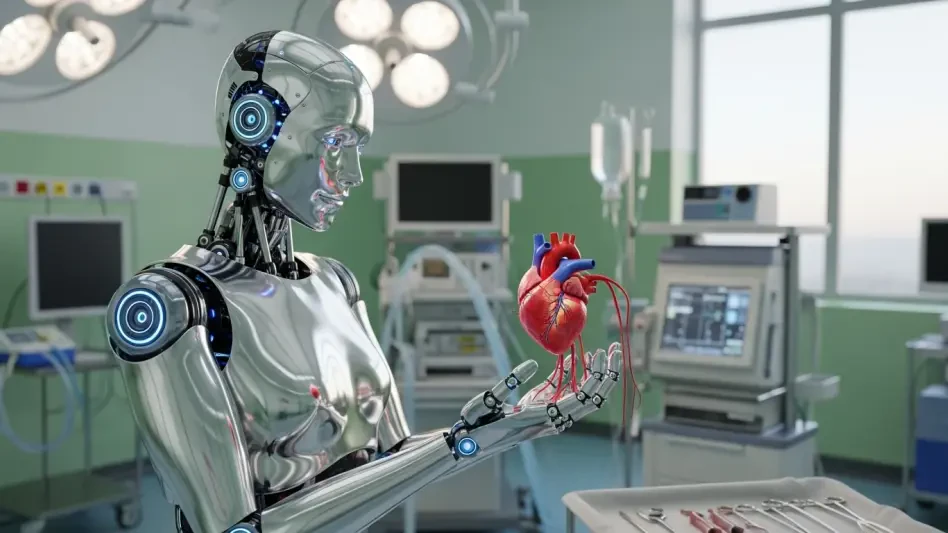Imagine a world where a simple, non-invasive device can detect heart disease before any symptoms appear, potentially saving millions of lives each year through early intervention. Heart disease remains the leading cause of death globally, claiming countless lives due to late diagnosis and delayed intervention. The integration of artificial intelligence (AI) into cardiovascular diagnostics offers a groundbreaking solution, transforming how medical professionals identify and manage this silent killer. This review explores the cutting-edge technology of AI-driven heart disease detection, delving into its core features, real-world impact, and the challenges that lie ahead in making this innovation a staple in healthcare.
Background of AI in Cardiovascular Health
The application of AI in cardiovascular diagnostics leverages advanced computational techniques to address a critical medical need. At its core, AI utilizes machine learning algorithms and vast datasets to analyze patterns that human senses or traditional tools often miss. In the context of heart disease, early detection is paramount, as conditions like arterial stiffening or vessel narrowing can progress undetected for years until a catastrophic event occurs. AI offers the promise of identifying these issues at their inception, providing a window for preventive measures.
The significance of this technology is underscored by the global burden of cardiovascular diseases. With millions of deaths annually attributed to heart-related conditions, the limitations of conventional diagnostic methods—such as inconsistent accuracy in standard stethoscope examinations—highlight the urgency for innovation. AI steps in as a powerful ally, enhancing precision and enabling healthcare systems to tackle one of the most pressing public health challenges of the modern era.
Core Features and Performance of AI Detection Tools
Digital Stethoscopes and Sound Analysis
One of the standout features of AI in heart disease detection is the use of digital stethoscopes to capture high-fidelity heart sounds. These devices serve as a non-invasive gateway, recording audio data that can reveal subtle anomalies in heartbeat rhythms. Unlike traditional tools, digital stethoscopes provide raw data with exceptional clarity, forming the foundation for AI systems to perform in-depth analysis without requiring invasive procedures.
The significance of this approach lies in its simplicity and accessibility. By focusing on sound as a diagnostic marker, the technology bypasses the need for complex imaging or lab tests in initial screenings. This makes it an ideal tool for widespread use, especially in settings where advanced medical equipment may not be readily available, thus broadening the reach of early detection efforts.
Machine Learning for Precision Diagnostics
Central to the performance of AI in this domain is the application of machine learning models designed for pattern recognition. These models are trained on extensive datasets of heart sounds, learning to distinguish between normal and abnormal acoustic signatures. For instance, they can detect minute changes indicative of conditions like arterial calcification, often achieving accuracy rates as high as 95% in identifying diseased states compared to much lower rates with traditional methods.
The strength of these algorithms lies in their ability to evolve and improve over time. As more data is fed into the system, the AI refines its understanding of complex patterns, pushing the boundaries of diagnostic precision. This adaptability ensures that the technology remains relevant even as new cardiovascular conditions or variations emerge, offering a dynamic solution to an ever-changing medical landscape.
Innovations and Emerging Trends
Recent advancements in AI-driven heart disease detection showcase a wave of innovation that promises to reshape cardiovascular care. Research from leading institutions has pioneered the use of sound-based AI diagnostics, focusing on non-invasive tools that can be deployed outside traditional clinical environments. Such developments emphasize creating systems that are not only accurate but also user-friendly, paving the way for broader adoption across diverse populations.
A notable trend is the shift toward preventive healthcare facilitated by technology. Patients are increasingly empowered to monitor their own health through accessible devices that integrate AI capabilities. This movement reflects a broader societal push for proactive wellness, where individuals take charge of their cardiovascular health long before a doctor’s intervention becomes necessary.
Additionally, there is growing interest in tailoring these tools for scalability. Innovations aim to integrate AI diagnostics into everyday devices, potentially transforming routine checkups into continuous monitoring systems. This trend aligns with the healthcare industry’s focus on reducing costs while improving outcomes, positioning AI as a cornerstone of future medical practice.
Real-World Applications and Impact
The practical deployment of AI in heart disease detection is already making waves in clinical settings. Hospitals and clinics are beginning to adopt these tools to complement existing diagnostic methods, allowing for earlier identification of at-risk patients. The technology’s ability to analyze heart sounds with high accuracy provides physicians with actionable insights, enabling timely interventions that can prevent severe outcomes.
Beyond clinical environments, the potential integration of AI into wearable devices marks a significant leap forward. Imagine a compact monitor, akin to a smartwatch, that continuously tracks heart sounds and alerts users to irregularities in real time. Such applications could revolutionize at-home health management, offering peace of mind to individuals with limited access to regular medical care.
A particularly impactful use case is in addressing healthcare disparities. By providing low-cost, portable diagnostic solutions, AI technology can reach underserved communities and rural areas where specialists and advanced equipment are scarce. This democratization of access ensures that early detection is not a privilege reserved for a few but a right available to many, fostering equity in global health outcomes.
Challenges and Barriers to Adoption
Despite its promise, AI-based heart disease detection faces several hurdles that must be addressed for widespread implementation. A primary technical challenge is the need for extensive, high-quality clinical data to train and validate these models. Without comprehensive datasets that represent diverse populations, the accuracy and reliability of AI diagnostics could be compromised, limiting their effectiveness in real-world scenarios.
Regulatory barriers also pose significant obstacles. The approval process for medical devices is rigorous, requiring extensive evidence of safety and efficacy. Navigating these requirements can delay the rollout of AI tools, even as the technology itself proves ready for deployment. Additionally, market challenges such as high development costs and resistance to adoption among healthcare providers further complicate the path to mainstream use.
Efforts to overcome these limitations are underway, with collaborations between research institutions, healthcare organizations, and funding bodies driving progress. Investments from health foundations and partnerships with academic centers are crucial in addressing data gaps and supporting clinical trials. These initiatives aim to build a robust framework that ensures AI diagnostics meet both medical and regulatory standards, paving the way for broader acceptance.
Looking Ahead: Future Prospects
The future of AI in cardiovascular health holds immense potential for transformative breakthroughs. Beyond its current focus on heart disease, the sound-based analysis approach could extend to other medical fields, such as orthopedics, where acoustic signatures might reveal joint or bone abnormalities. This versatility suggests that the underlying technology could become a multidisciplinary tool, expanding its impact across healthcare.
Another exciting prospect is the transition of AI diagnostics into routine clinical practice over the coming years. As data collection improves and regulatory pathways become clearer, the integration of these tools into standard medical protocols seems imminent. This shift could redefine how checkups are conducted, moving from reactive responses to proactive, data-driven strategies that prioritize prevention.
The long-term societal benefits are profound, promising improved health outcomes on a global scale. By reducing the incidence of late-stage heart disease through early detection, AI has the power to alleviate the economic and emotional burden of cardiovascular conditions. This vision of a healthier future hinges on continued innovation and collaboration, ensuring that technology serves as a bridge to better care for all.
Final Thoughts and Next Steps
Reflecting on the journey of AI in heart disease detection, it is clear that this technology has already achieved remarkable milestones, with accuracy rates surpassing traditional methods and opening doors to preventive care. Its real-world applications have demonstrated tangible benefits, from clinical enhancements to the promise of wearable solutions. The impact on healthcare equity has also been a standout achievement, bringing diagnostics to those previously out of reach.
Looking back, the challenges of data acquisition, regulatory hurdles, and adoption barriers are significant yet surmountable with concerted effort. The next steps involve scaling up clinical trials to gather diverse datasets, ensuring that AI models are robust across populations. Stakeholders need to prioritize partnerships that accelerate regulatory approvals while maintaining rigorous standards.
Ultimately, the focus must shift toward integrating these tools into everyday healthcare practices, making them as commonplace as routine blood pressure checks. Investment in public awareness campaigns could drive acceptance among patients and providers alike. By addressing these actionable priorities, the legacy of AI in cardiovascular diagnostics is poised to be one of lasting transformation, ensuring earlier interventions and healthier lives for generations to come.









